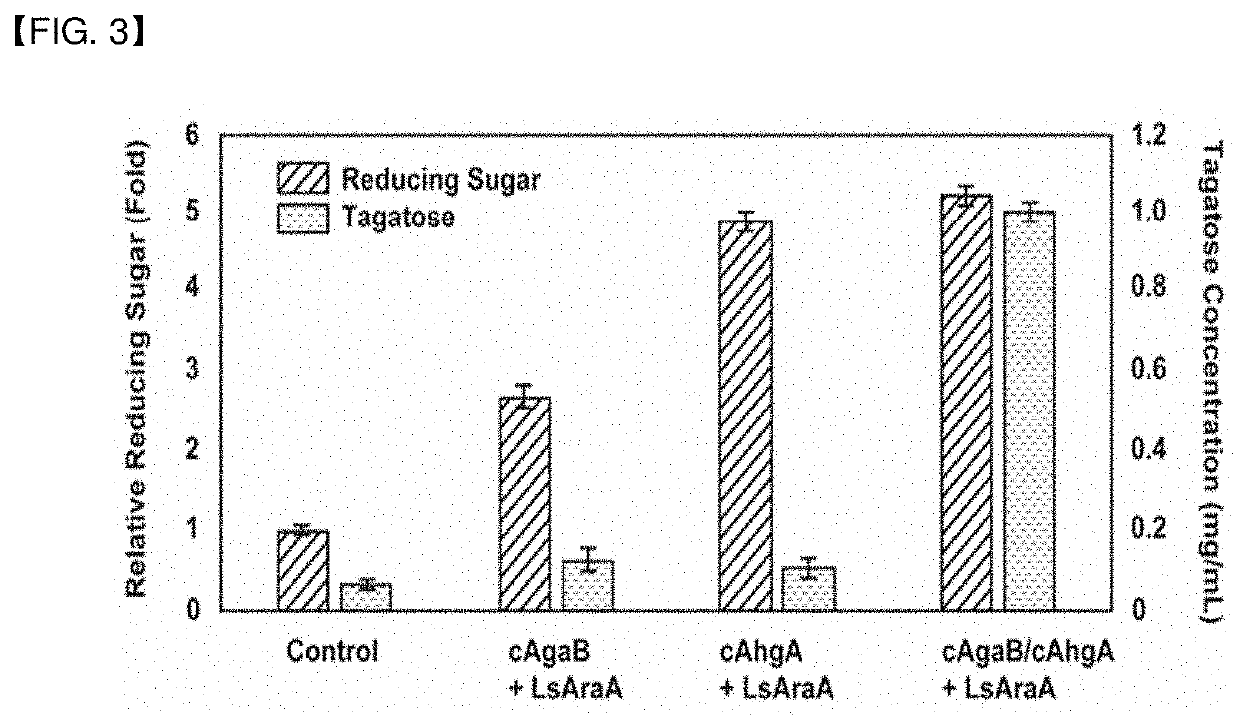Agarase-3,6-anhydro-l-galactosidase-arabinose isomerase enzyme complex and method for production of tagatose from agar using the same
a technology of arabinose and isomerase, which is applied in the direction of enzyme stabilisation, peptides, peptide sources, etc., can solve the problems of inability to easily break down, difficulty in using it as a substrate for biofuel production, and inability to easily achieve the effects of reducing production costs, maximizing production efficiency, and simple process of enzyme complex formation
- Summary
- Abstract
- Description
- Claims
- Application Information
AI Technical Summary
Benefits of technology
Problems solved by technology
Method used
Image
Examples
example 1
n Vector for Novel Enzyme Complex
[0050]In order to prepare a novel enzyme complex, a vector and a transformant including genes encoding the components of the enzyme complex were prepared.
[0051]1.1 Lactobacillus-Derived Arabinose Isomerase Expression Vector
[0052]For cloning of proteins for producing tagatose from an agar degradation product as a substrate, a vector expressing the arabinose isomerase gene was prepared first.
[0053]Referring to the base sequence of the arabinose isomerase (LsAraA) gene from the gDNA of bacteria in the genus Lactobacillus, primers were designed and synthesized such that the Sac I recognition sequence was inserted to the 5′ end of a forward primer (SEQ ID NO 2) and the Hind III recognition sequence was inserted to the 5′ end of a reverse primer (SEQ ID NO 3). Then, PCR was conducted using the synthesized primers. As a result, the PCR band of the 1479-bp arabinose isomerase (LsAraA) gene (SEQ ID NO 4) was observed (result not shown).
[0054]Then, the arabino...
example 2
ion of Arabinose Isomerase Enzyme Complex with Mini Cellulose-Binding Protein Linked and Analysis of Activity for Galactose Substrate
[0071]2.1 Construction of Expression Vector for Enzyme Complex
[0072]For cloning of the mini cellulose-binding protein A gene having a cellulose-binding module (CBM) and two cohesin modules of cellulose-binding protein A which is the primary scaffolding subunit of Clostridium cellulovorans, primers were synthesized such that the BamHl recognition sequence (ggatcc) was inserted to the 5′ end of a forward primer (SEQ ID NO 15) and the XhoI recognition sequence (ctcgag) was inserted to the 5′ end of a reverse primer (SEQ ID NO 16) referring to the base sequence. As a result, a 1659-bp PCR band containing the mCbpA gene (SEQ ID NO 17) which is a part of the cellulose-binding protein A gene derived from Clostridium cellulovorans was observed (result not shown).
[0073]2.2 Confirmation of Enzyme Complex Formation
[0074]In order to confirm the formation of a comp...
example 3
ion of Enzyme Complex Expression Vector for Agar Degradation Product
[0077]For production of tagatose from the less expensive substrate agar, a fusion protein including agarase and dockerin and a fusion protein including 3,6-anhydro-L-galactosidase and dockerin were designed.
[0078]3.1 Preparation of Enzyme Complex (Fusion of β-Agarase and Dockerin)
[0079]A. Isolation of β-Agarase Gene
[0080]In order to bind β-agarase to the dockerin gene, primers for processing both ends of the β-agarase gene were prepared. Primers were designed and synthesized such that the Sac I recognition sequence was inserted to the 5′ end of a forward primer (SEQ ID NO 18) and the referring to the base sequence of the β-agarase AgaB gene from the genomic DNA of bacteria in the genus Zobellia and a 10-bp sequence at the N-terminal was inserted to the 5′ end of a reverse primer (SEQ ID NO 19) referring to the base sequence of the dockerin moiety of the endo-β-1,4-glucanase B gene derived from Clostridium cellulovor...
PUM
| Property | Measurement | Unit |
|---|---|---|
| Molar density | aaaaa | aaaaa |
Abstract
Description
Claims
Application Information
 Login to View More
Login to View More - R&D
- Intellectual Property
- Life Sciences
- Materials
- Tech Scout
- Unparalleled Data Quality
- Higher Quality Content
- 60% Fewer Hallucinations
Browse by: Latest US Patents, China's latest patents, Technical Efficacy Thesaurus, Application Domain, Technology Topic, Popular Technical Reports.
© 2025 PatSnap. All rights reserved.Legal|Privacy policy|Modern Slavery Act Transparency Statement|Sitemap|About US| Contact US: help@patsnap.com



